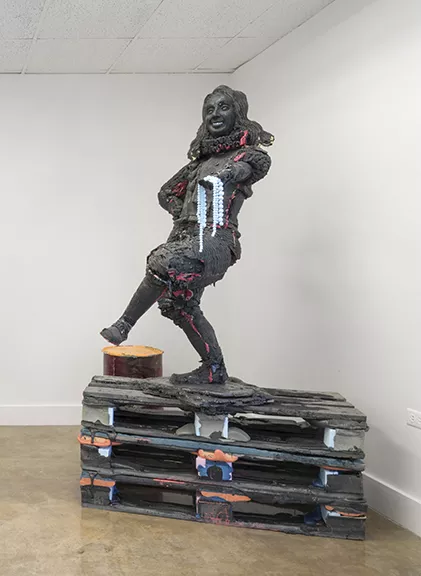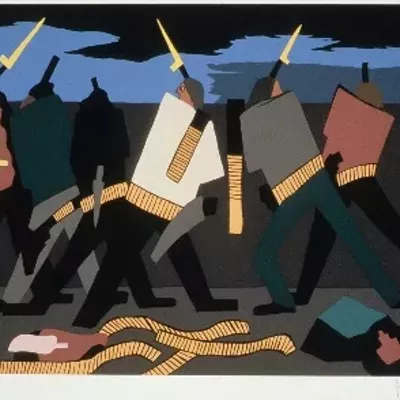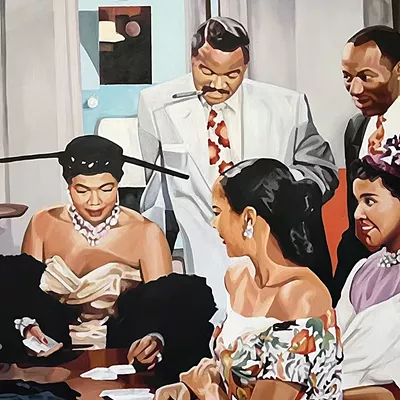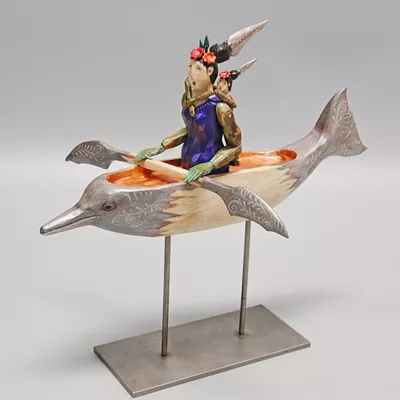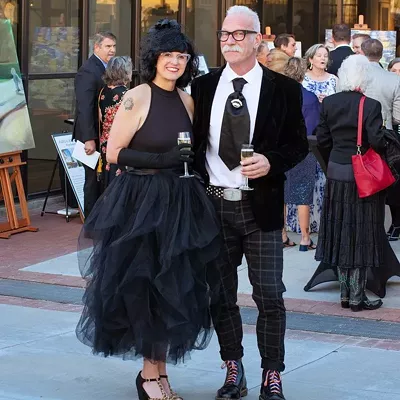Years ago, when the island of Manhattan was the domain of Native Americans, a band of Dutch fur traders quietly sailed into New York Bay.
The newcomers landed on a small island a stone's throw away from Manhattan and set up a fur trading post. The next year, in 1625, escalating their incursion, the Dutch built a fort across the water in Manhattan itself. A year after that, in 1626, they made a paltry payment for the land they had stolen.
Legend has it that Peter Minuit of the Dutch West India Company paid the Indians in trade goods worth $24.
Dutch artist Fokert de Jong memorializes this tawdry capitalist conquest in a scathing sculptural installation, "The Trader's Deal," one of 27 mostly massive pieces in Last Nation, a major de Jong show at MOCA-Tucson.
Using a figure from the painting "The Night Watch" by his countryman Rembrandt as a model, de Jong created three grinning colonists dancing jigs to celebrate the swindle. Each holds a cheap beaded necklace, the trade good that tricked the tribes.
Made of foam and pigmented polyurethane, the dark figures are dressed in the elaborate Dutch collars and knickers of the 17th century, the great age of Dutch exploration and colonization and land theft. Not so incidentally, that century was also the golden age of Dutch painting.
The rise of the great Dutch painters—Rembrandt, Vermeer, Judith Leyster, Franz Hals—was fueled by the new wealth generated by the Netherlands' colonization of Manhattan and other territories around the world.
In his art, de Jong grapples with this problematic history. Tormented by his country's long-ago global conquests, he trades in darkness, making large sculptural works that bear witness to the horrors of colonialism, to the avarice of capitalism, to the savagery of war. But he uses satire and brilliant color amidst all the gloom, while also paying homage to the great artists who came before him.
De Jong himself is a master of the art of the human body. The faces in his many life-size figurative works—almost all of them made out of the outlaw art materials of foam and polyurethane—have the sensitivity of Rembrandt's heartbreaking portraits.
And he follows that master in making self-portraits that dig deep psychologically, exposing his own anxieties. In "Off the Grid," a life-size de Jong nude hangs on a wall. Colored all over in burnt orange and black, the imperfect figure appears to be dead. His eyes are closed and his head hangs forward. This eerie three-dimensional piece was made from a mold of de Jong's own body, a laudable process explained in a documentary playing in the gallery.
The early Renaissance painter Brueghel is evoked in "The New Deal," a woeful sculpture of a bent-over old man modeled on a Brueghel painted figure.
And de Jong lionizes the Dutch modernist Piet Mondrian, master of painted geometries. Mondrian appears in several sculptural portraits, and his paintings are invoked in two beautiful wall works, "Lost Boogie Woogie (Blue-Pink)" and "Boogie Woogie (Black Drip)," both inspired by Mondrian's last work, an unfinished abstraction inspired by the street grid in—of all places—Manhattan.
De Jong made the works by arranging flat layers of foam into a pleasing diamond shape and digging into them with a sharp tool, etching out a network of vertical and horizontal lines. He painted them with déclassé polyurethane in jazzy shades of pink and blue and black.
They're lovely pieces, seeming at first to be nothing more than soothing abstractions. But a gallery note explains that those innocent-looking lines actually mimic aerial shots of bombings. They're a portent of war.
Even the rollicking "Weird Science-BMW," a jazzily painted full-size art car, painted in the splashy style of the New York abstract expressionists—look for the Jackson Pollock drips—isn't as fun as it looks on the outside. Parked inside the museum's Great Hall, it turns out the car's interior is a safe space for Mondrian and his real-life art buddy Theo von Doesburg. (The duo founded the De Stijl art movement calling for a simplified aesthetic across art genres.) Through cracks in the car you can see their foam bodies lying inside.
Lucky they got in when they did: all around the car are sealed metal containers with labels announcing toxic contents. The messy floor is strewn with ominous white tablets and broken-down wired machines; it's a veritable stew of pestilential poisons. Pollution is one more woe that de Jong tackles; even the foam he uses to build his figures and the polyurethane he paints them with are reminders of the pernicious chemicals that infest the modern world.
This powerful show may tilt Dutch, but it engages with issues worldwide. Peter Minuit was not the only "First World" invader to cheat and steal from "Third World" native peoples for profit. He was a precursor, not only to the savage genocide the U.S. waged on Indians in 19th-century America, but to many other depredations around the planet.
Proving the point, in "Totemism" de Jong created an extraordinary company of saints and sinners from around the world. Standing in a Stonehenge-like circle at the entrance to the gallery, carved like African cultures, the 10 massive foam figures represent numerous countries. Some, like capitalist thief Bernie Madoff and Louis XIV, the absolutist Sun King, are out-and-out bad guys. But even the good guys are flawed: George Washington, the revered father of the nation, owned human slaves; Fidel Castro, an idealistic freedom fighter, turned authoritarian.
Another work, "The Knight's Move," a life-sized sculpture of a dead soldier, is a reminder of the mass deaths that flawed leaders—and capitalists—can cause. Minuit might not have intended to cause the deaths of a thousand people in old Manhattan, but he did. Fifteen years after he transacted his $24 bargain, war broke out on the island, with a Dutch massacre of Indian men, women and children followed by retaliation. Both sides suffered massive casualties.
In "The Knight's Move," the soldier wears a Dutch Navy uniform that once belonged to de Jong's uncle. But entombed in a Plexiglas coffin tinted red, his ghostly corpse becomes an everyman, the universal soldier who dies for someone else's sins.

